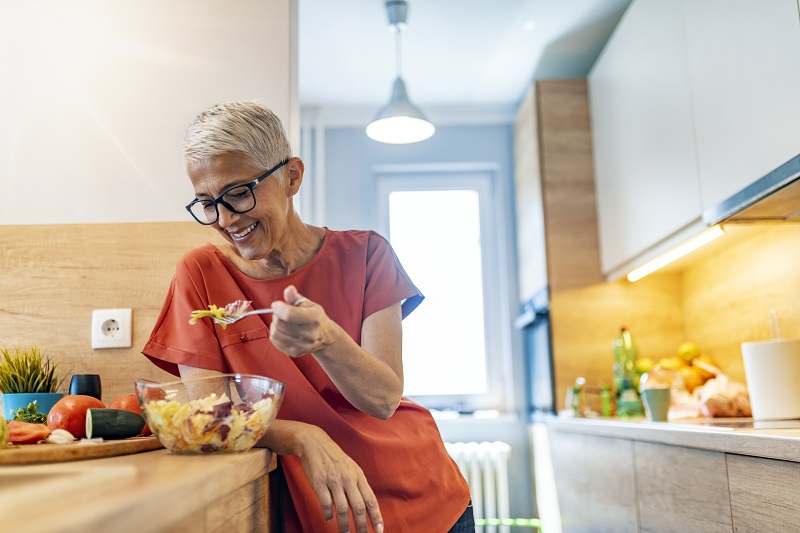Everyone’s stuck at home. Even our heroic essential workers finish their shifts, come home and are confined to their houses.
The social distancing is, of course, good for everyone’s health to prevent the spread of the Coronavirus (COVID-19). And if we’re lucky, all of this good work could mean that everyone gets back outside for summer—hopefully, we’ll be able to gather at barbecues, head to the beach, bond with family on vacation, take in a ballgame or just head to the park for a sunny day together.
If you’ve got the time and energy, you can use this extra time at home to make sure your body is ready for all that summer fun. Achieve your fitness and energy goals in order to do all of the outdoor things you want to do this season. Keep reading for some simple ways to help turn this stuck-inside time into a summer-ready body—at the kitchen table, on the couch and when you’re moving around in and out of the house.
Here are some simple ways to get your body summer-ready while stuck at home:
At meal times: Eat more fiber

Losing weight and toning up starts in the kitchen, not the gym. That’s why Nutrisystem is all about providing a healthy meal plan that is filled with nourishing (and delicious!) food. There are very few things that you can eat that will help firm up your middle like fiber. The essential nutrient, found in vegetables, fruits, oats and more, helps you feel full faster and keeps you feeling fuller for longer. More important for your beach bod, fiber has the ability to help you lose belly fat: For every 10 grams you eat each day, studies show you could have as much as four percent less fat around your middle, says Science Daily.
That’s one reason Nutrisystem encourages members to eat four servings of non-starchy vegetables per day. These veggies, like cucumbers, broccoli, spinach and more, aren’t just low in calories and packed with nutrients your body needs. They’re also loaded with fiber that help keep you satisfied. That’s also why Nutrisystem meals, snacks and shakes feature extra fiber—even pasta favorites like the Lasagna with Meat Sauce have some dietary fiber built in! That way, you can enjoy comfort foods you love while getting the filling nutrients your body needs to reach your goal weight at home.
When you’re snacking: Have some healthy fats

Another nutrient that targets fat… is fat! Specifically, the right, “healthy” kind of fat. Monounsaturated fats, like those found in seeds, fatty fishes and olive oil, have actually been found to help dieters lose belly fat, says Science Daily. That’s why Nutrisystem makes decadent-tasting snacks that can help you lose weight. Member favorites like the Dark Chocolate and Sea Salt Nut Bar are loaded with healthy fats in a delicious snack option that satisfies.
You can get those healthy fats from your non-Nutrisystem snack time, too. Almonds are super fat-fighters for your trouble spots. In one study, published in the Journal of the American Heart Association, dieters who were given a measured, daily snack of almonds lost fat in their bellies and legs, even if they didn’t lose weight overall.
When choosing healthy fats for snacks, you still want to stay portion smart. Check out the Nutrisystem Grocery Guide for the perfect PowerFuel portion size. For almonds, you can enjoy a half-ounce or two tablespoons as one PowerFuel serving on Nutrisystem.
In the house: Try a home workout

The gym may be closed but you’ve got the ultimate fitness machine right in your house—your body! You can try these five no-crunch moves for flatter abs, do some easy exercises without even getting out of your chair or grab a milk jug (or bag of dog food or tub of kitty litter) and do this simple, five-move workout at home.
To do this workout, perform each exercise for five repetitions, then move to the next exercise resting as little as possible while staying composed. You don’t want to be completely rested but you also don’t want to put yourself in danger of falling or having another injury. After you’ve finished all five moves, rest for 30 seconds to one minute, then repeat. Go for two rounds the first time. Try to do two or more rounds of this workout as many times as you can each day—if you’ve got time for five rounds… great! If you’ve only got time for two rounds now and two rounds later… great! Try to improve the number of rounds you do total each week.
- Exercise 1: Goblet Squat
- Hold the milk jug in front of your chest with both hands, your elbows close together and your hands cupping the jug. In this position, your forearms will look like a goblet. Stand with your feet hip-width apart, toes pointed slightly out from parallel. Push your hips back to initiate the squat. Bend your knees to descend until your thighs are at least parallel to the floor, keeping your chest up and your weight on your heels. Keep the weight of your body in your heels and press back to standing. Repeat.
- If you’re not used to squatting and want to make this exercise easier, try it without the jug. To make it even easier than that, set up for the exercise with a chair or box behind you. Push your hips back to squat and slowly lower yourself until you’re seated. Try to stand back up out of the squat without using your hands.
- Exercise 2: Elevated Pushup
- Place your hands on the second or third step of the staircase. In this position, your hands should be directly beneath your shoulders and your body forming a straight line from head to heels. Maintaining this straight body line, bend your elbows to lower your chest until it touches the step—don’t reach with your head! Then push back up.
- To make this move easier, use a higher step on the staircase so that your hands are elevated even more. You can also do presses against the wall.
- Exercise 3: Bent-Over Row
- Stand holding the milk jug in front of you with your feet hip-width apart and a slight bend in your knees. Initiate the hip hinge like this: Imagine you’re holding a box or a big bag of groceries in your arms in front of you as you stand straight, and you’re going to close a car door that’s behind you using your butt. Bump the door closed with your butt—doing this will push your hips back. Keep pushing your hips back (instead of bending at the waist) to push your chest towards the floor. This should help you maintain a flat back. Once you’re bent forward, the jug will be hanging below your chest. Bend your elbows to row the jug up to your chest, then return it to hanging. Repeat this five times.
- Exercise 4: Step Up
- Holding the milk jug in front of your chest, stand with a sturdy chair, bench or box in front of you. You can also stand in front of a flight of stairs. Keep your torso upright as you place your right foot on the chair and press through your heel to bring your left foot up so you’re standing on the chair. Control your descent as you return to start. Continue performing step ups on this leg for five repetitions, then switch legs and repeat.
- To make this move easier, use the first step of the staircase instead of the second. Perform the exercise in the same way otherwise.
- Exercise 5: Overhead Press
- Sit in a chair and hold the milk jug in front of your chest with both hands, palms facing together. Keeping your chest proud and your elbows close to your sides, press the jug up overhead until your arms are nearly straight. Bring it back to your chest. Repeat this move five times.
On your outdoor time: Add weight to your walk

Many people are able to get out of the house for some sunshine and stepping while social distancing. Walking is a great workout that you can do almost anywhere! Just 22 minutes of walking per day could help you lose up to 20 pounds in a year. Making a few simple tweaks to your walk could make it burn even more.
First, try to vary your pace—even just a little. Studies have shown that faster bursts of walking (even just five inches per second faster) helped walkers burn up to 20 percent more calories than keeping a constant pace. Try setting a timer on your walk so that every two minutes, your phone beeps. When it does, pick up the pace just a little bit for 30 seconds. Return to your normal pace until the next beep.
You can also amp up your calorie burn at home by adding a little weight to your walk. “Rucking” is an activity where exercisers walk, march or run with heavy packs on their backs. It seriously increases the calories you’ll use: According to the Compendium of Physical Activities, a 200-pound man will burn 378 calories when rucking for 30 minutes, compared to burning just 141 calories when walking without the pack. The pack doesn’t have to be super heavy either: Try starting with just a backpack that has a few heavy books in it. Work your way up to bags that are up to 10 percent of your body weight. The added weight will give your walk a fitness boost.
The post How to Get Your Body Summer-Ready While Stuck at Home appeared first on The Leaf.




Comments
Post a Comment